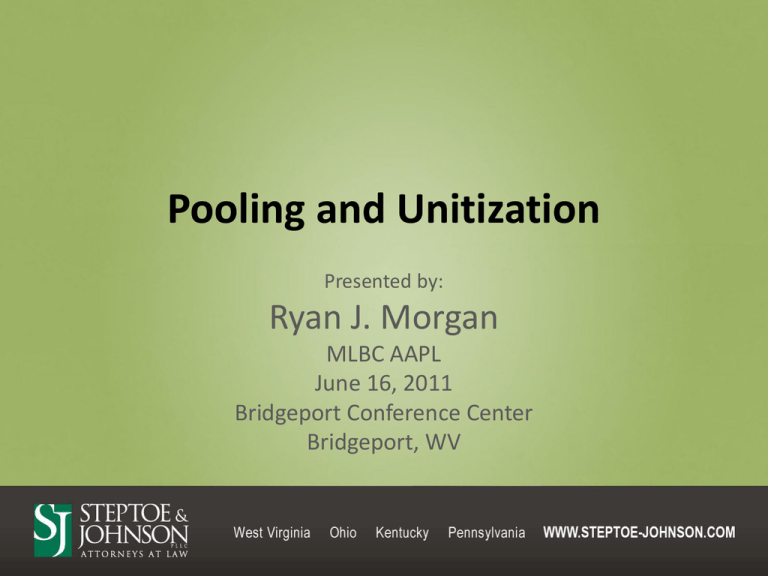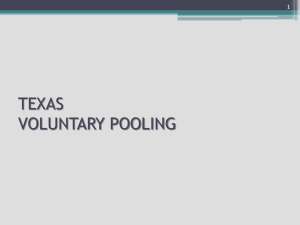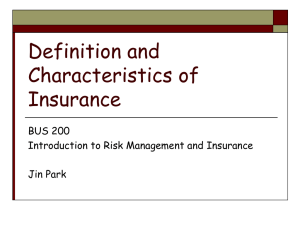Pooling and Unitization
advertisement

Pooling and Unitization Presented by: Ryan J. Morgan MLBC AAPL June 16, 2011 Bridgeport Conference Center Bridgeport, WV Material Disclaimer These materials are public information and have been prepared solely for educational purposes to contribute to the understanding of energy and oil and gas law. These materials reflect only the personal views of the author and are not individualized legal advice. It is understood that each case is fact-specific, and that the appropriate solution in any case will vary. Therefore, these materials may or may not be relevant to any particular situation. Thus, the author and Steptoe & Johnson PLLC cannot be bound either philosophically or as representatives of their various present and future clients to the comments expressed in these materials. The presentation of these materials does not establish any form of attorney-client relationship with the author or Steptoe & Johnson PLLC. While every attempt was made to insure that these materials are accurate, errors or omissions may be contained therein, for which any liability is disclaimed. What motivates this presentation topic? #1 Understand background of pooling concepts #2 Understand uses of pooling clause in lease and importance of language and terms What We Are Going to Cover • Review of pooling • Current pooling laws in OH, PA , and WV • Discussion of issues with use of pooling/ unitization in the development of horizontal wells • Review of lease provisions 5 An Overview – Origins and Evolution of Pooling The key to understanding oil & gas law…. Origins of Pooling In the beginning… The Rule of Capture ferae naturae Origins of Pooling The Rule of Capture THE DECISION: YOU PRODUCE IT… YOU OWN IT ! Origins of Pooling The Rule of Capture THE RESPONSE: DRILL YOUR OWN DARN WELL ! Origins of Pooling The Rule of Capture THE RESULT: Origins of Pooling The Rule of Capture THE AFTERMATH: GOVERNMENT ACTION & THE EXERCISE OF “POLICE POWERS” Origins of Pooling Emergence of the concepts (pooling and unitization) Surely there is a better way to do things… Origins of Pooling Distinguishing contractual/voluntary integration from statutory unitization or pooling History & Development of Pooling Review of development in the states Current Pooling Laws Ohio Statutory Pooling in Ohio General statewide spacing and unit size is authorized in 1509.24 to be set by rule Current general rule is: 0-1000 feet in depth 200 feet from any well in the same pool 100 feet from a tract or unit boundary 1000-2000 feet 10 acre tract 2000-4000 feet 20 acre tract 4000 feet or deeper 40 acre tract Statutory Pooling in Ohio • No distinction between shallow and deep wells as in WV or PA • Section 1509.27 authorizes mandatory pooling orders • Section 1509.28 permits unitized operations • Section 1509.29 permits exception tracts subject to production allowable where statewide or special rules would otherwise preclude development Mandatory Pooling Applications Application submitted to the Director with information required by statute or rule including: a) description of the unit boundaries b) identification of drill site c) ownership of tracts d) explanation of need for mandatory pooling e) evidence of attempts to form voluntary unit f) estimated costs g) limit of 5 pooling applications per person per year h) no surface operations are permitted on tracts which are force pooled Review by Technical Advisory Council • The Technical Advisory Council on Oil and Gas was created under Section 1509.38 of the Ohio Revised Code. The T.A.C. consists of eight members appointed by the Governor and meets once a calendar quarter. • The applicant must submit all the information required to the Division at least forty days prior to a scheduled T.A.C. meeting to ensure scheduling of their request on the T.A.C. agenda. • The Division provides T.A.C. members with the documentation provided by the applicant at least two weeks prior to the hearing. Pennsylvania Pooling in Pennsylvania 58 P.S. § 403 – applies to all wells except those that are less than 3,800 ft. or do not penetrate the Onondaga (Marcellus wells do not qualify as Conservation well) 58 P.S. § 405(c)(1)(iv) – gives Oil & Gas Conservation Commission specific authority, upon proper application, to enter spacing and pooling orders and provide for the integration or communitization of interests within a drilling unit 58 P.S. § 408 provides that two or more separately owned tracts can be voluntarily integrated to create a pool 23 Recent Attempts at Legislation SB 447 (Yaw, White, Mensch, Fontana 2/11/2010) – Places statutory integration in the PUC – 65% ownership threshold to invoke the act – Horizontal wells and unconventional formations – A “shade” of the industry consensus bill of 2010 West Virginia Spacing in West Virginia Spacing Rules in WV • Shallow Wells • < 3000 ft.- Min. distance of 1000 ft. from nearest existing well • >3000 ft. -Min. distance of 1500 ft. from nearest existing well • (If coal owner objects, gas operator has burden to establish need if nearest existing well is between 1500-2000 feet) • Deep Wells • Completed below Onondaga formation • Oil & Gas Conservation Commission determines spacing Pooling in West Virginia Statutory Pooling 1. Shallow Wells 2. Deep Wells & Secondary Recovery 3. Coalbed Methane Wells Pooling in West Virginia Deep Wells – Pooling Process 1. Operator must drill “discovery well” to establish pool 2. Application then filed by operator of well or other operator affected by a well in the pool 3. Notice, including area to be covered by spacing order 4. O&G Conservation Commission enters order setting spacing and acreage for each drilling unit 5. Must have lease/agreement on tract where drilling operations will be located 6. Operator must have written consent and easement from surface owner of record identifying the well location Development Issues Pooling vs. Unitization Often used interchangeably, these words have traditionally had unique meanings Example of a Modern Unit » » » » » Chesapeake Durig Unit 603 Acres 20 Tracts Largest tract 109 ac. Smallest tract 0.08 ac. How is pooling accomplished? Voluntary • Pooling clause in lease or subsequent agreement needed to bind lessor’s interest • Amends lease habendum (term) clause – unit operations maintain lease beyond primary term • Amends royalty clause – pay fractional part Issue - Apportionment Apportionment Rule – all owners of subdivided tracts under one lease entitled to royalty – Followed in PA, CA, MS – Example: A, B, C each get 1/3 Subdivided Tracts (one lease) A Unit Well B C Issue - Apportionment Non-Apportionment Rule – owner of subdivided tract where well is located is entitled to all royalties – Followed in AR, CO, IL, IN, KS, KY, LA, NE, NM, OH, OK, TX, WV Subdivided Tracts – Example: A gets all royalties (one lease) A Unit Well B C Issue - Apportionment Non-Apportionment Rule can be avoided by Entireties Clause – Example: “If the leased premises shall hereafter be owned severally or in separate tracts, the premises nevertheless shall be developed and operated as one lease and all royalties accruing hereunder shall be treated as an entirety and shall be divided among and paid to such separate owners in the proportion that the acreage owned by each such separate owner bears to the entire leased acreage.” How is pooling accomplished? Involuntary = Statutory Integration (“Force Pooling”) • Exercise of police power by state • Ordered to prevent waste, increase ultimate recovery, avoid drilling of unnecessary wells, protect correlative rights • Widespread in producing states Issue – Use of Premises Can regulatory commission permit unit well to be located on unleased premises over objection of owner? Some courts permit owner to maintain action for surface damages against unit operator (see Cormack v. WIL-MC Corp., 661 P.2d 525 (Okla. 1983)) A B Leased Tract Unleased Tract – Can drill well on B? Well Lease Provisions Sample Lease Term Unitization/Pooling Clause Lessor hereby grants to the Lessee the right at any time to consolidate the leased premises or any part thereof or strata therein with other lands to form an oil and gas development unit of not more than 640 acres, or such larger unit as may be required by state law or regulation for the purpose of drilling a well thereon, but the Lessee shall in no event be required to drill more than one well on such unit. Any well drilled on said development unit whether or not located on the leased premises, shall nevertheless be deemed to be located upon the leased premises within the meaning and for the provisions and covenants of this lease to the same effect as if all the lands comprising said unit were described in and subject to this lease. Key Provisions • Lease Must Allow Pooling – Grant Lessee Authority to Form Pool/Unit (i.e., you do not have to come back to the lessor) – Avoid restrictions (e.g., well must be on/off lessor’s land, lease must contribute minimum % to the unit, etc.) • Spell out calculation/division of Royalties – Should be consistent from lease to lease – Should be clear and based on engineering/geology • Pooling of any acreage construed as “Operations” on the leasehold – Hold acreage without need to drill on each leasehold Issue - Allocation & Payment Royalties may be based on surface acreage Royalties may be based on formula (e.g. acre feet, net reservoir pay, material balance, determination of remaining reserves, present production, cumulative production, surface acres underlined by productive reservoir, number of usable wells bores) Method should be clearly expressed in leases and administrative orders Issue – Development Obligations Set out the basis for unit size and shape Replace implied covenants with express obligations THANK YOU !










